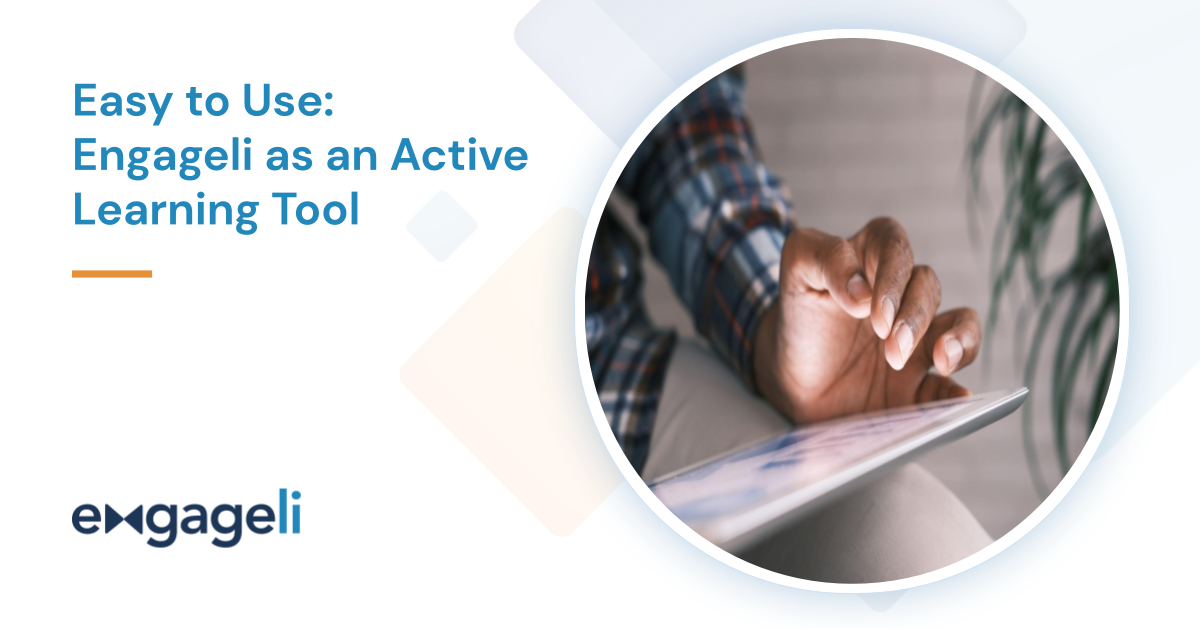The Easy to Use category has the following two criteria, “easy to learn” and “easy to configure.” Let us take a look and see how Engageli addresses each of these.
Easy to learn
The definition of “easy to learn” has three parts:
- Easy for all to access
- Easy for students to become skillful
- Easy for instructors to become skillful
Easy for all to access
Part of the story for “easy to learn” is that the technology has to be easy to access. Engageli is a Web app that works on either Chrome or Edge browsers—no app download is necessary. Further, a free iOS app is available (Android app coming soon) for students who want to work from their tablet or phone. Given the easy availability of all of the above, any student with a computer can use Engageli. Once the student or instructor has started Engageli for the first time, he or she is presented with a login screen that allows them to set their audiovisual options. It also presents a “Test your system” link that runs a series of automated tests to address any audiovisual glitches that may arise. For those who might be interested, the “Troubleshoot” link plays a video explaining Engageli’s use of audio & video devices. After signing on to Engageli, a new user is given the option to take a brief tour (< 1 minute to complete) of its features. Thus, given all of this support, it’s easy for both instructors and students to access (and then sign on to) the Engageli platform.
Easy for students
Engageli has an intuitive interface, which means learners will adjust to the new tool seamlessly. Engageli has an easy-to-use layout that empowers learners to play an active role in their learning. Check out this interactive graphic to see how easy the interface is to use.
Easy for instructors
Instructors work in the same Web app with the same layout as described above. Some minor differences allow the instructor more control of the classroom.Engageli removes the friction that exists in moving an engaging face-to-face learning experience to an online space. Not only is the software easy to use, but redesigning classes that are going to be taught online could be a thing of the past. Instructors do not have to remove the engaging, interactive, and effective group projects when going online. Having this additional functionality removes a whole category of work from the instructor (and, possibly, instructional design personnel) in the move online.
Easy to configure
The authors defined “easy to configure” in this way: “Instructors can easily configure settings to the desired starting state for the activity. Depending on the context, it can be suitable for instructors to require preliminary training in order to configure settings successfully. Configuration takes minimal time and can be set up in advance.”Two stages of configuration are necessary for Engageli: setup by IT in order to integrate it into the institutional tech stack and setup by the instructor in order to set it up for a class session.
- Easily configure settings for an institution: An institution’s IT staff can integrate Engageli into its LMS and/or SIS with a simple 30-minute video call. These connect via LTI 1.3 in order to enable roster sharing and single sign-on. The instructor will never be aware of this other than the fact that Engageli is available for his/her classes.
- Easy configure settings for a class: Engageli enables the instructor to complete many activities before class starts via standard Web forms:
- Set the table size for that class (from 1-10)
- Load the slides, videos, and documents for that day’s class
- Set up a variety of pre-defined groups that can be applied with a single click during the class (while retaining the ability to use randomized groups if desired).
The technical integration setup is performed by the organization’s IT group and conforms to industry standards. The daily class setup process supports the tasks that any instructor has to go through before a class, but it allows more settings (e.g., group configuration) to be handled before a class, thus simplifying the mental load on the instructor during the class.
Summary
Engageli passes both the “easy to learn” and “easy to configure” requirements for active learning technologies and, thus, passes the “easy-to-use” category in the rubric. It is easy for a student to access and use. It is also easy for a professor to use and to begin teaching in. The real difference with Engageli is that it also makes it easy for a professor to teach highly engaging classes that encourage students to participate. The next post of this series will be on the criteria: ‘Participation.’Interested in getting a live demo of Engageli to experience for yourself how it enables active learning? Reach out to partnerships@engageli.com

